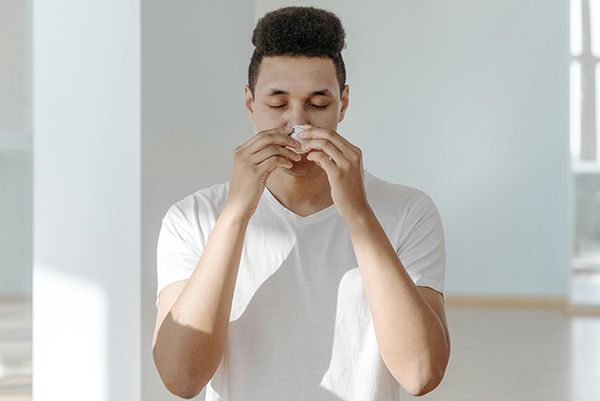
Understanding Seasonal Allergies
Seasonal allergies occur when the immune system reacts to airborne substances like pollen from grasses, trees, and weeds that are more prevalent during specific times of the year.
1. Spring and Summer:
Grass pollens, such as ryegrass and Bermuda grass, are the predominant allergens during these warmer months when grasses are actively flowering.
2. Late Summer and Autumn:
Pollen from weeds becomes more common, and in humid coastal regions, mould spores may also peak.
The allergic reaction starts when the immune system mistakenly identifies these airborne particles as dangerous, releasing histamine and other chemicals that cause the symptoms commonly associated with hay fever.
Symptoms of Seasonal Allergies
Typical symptoms include:
- Nasal: Sneezing, congestion, runny nose.
- Ocular: Itchy, watery, red eyes.
- Other: Itchy throat, cough, and headaches.
Preventive Measures
Minimizing exposure to allergens is key to prevention:
1. Home Environment:
Employ air purifiers with HEPA filters to reduce indoor allergens.
Keep windows closed on high pollen days, especially when it’s windy or following thunderstorms, which can exacerbate symptoms.
2. Personal Habits:
Shower and wash hair after being outdoors to eliminate pollen.
Change clothes after returning indoors to prevent spreading pollen inside your home.
3. Pollen Forecasts:
Monitor local pollen counts and plan outdoor activities for times when pollen levels are lower.
Treatment Options
There are several treatment approaches to alleviate symptoms:
1. Medications:
- Antihistamines: Reduce symptoms such as sneezing and itching. Opt for non-sedative forms to avoid drowsiness.
- Intranasal corticosteroids: Effective for severe nasal symptoms, these sprays reduce inflammation. It’s beneficial to start using them just before the season begins.
- Decongestants: Provide short-term relief from nasal stuffiness but are not suitable for prolonged use.
2. Immunotherapy:
- Useful for severe allergy sufferers, this treatment method involves desensitization to allergens through regular injections or sublingual tablets.
Lifestyle and Dietary Adjustments
Dietary and lifestyle changes can enhance medical treatments:
1. Diet:
Include foods high in omega-3 fatty acids and antioxidants to help reduce inflammation.
Herbal teas like ginger and peppermint can soothe the throat and alleviate symptoms.
2. Exercise:
Regular physical activity can improve immune function and potentially reduce the severity of allergy symptoms. However, it’s best to avoid outdoor exercise when pollen counts are high.
Conclusion
Effectively managing seasonal allergies involves a multifaceted approach tailored to local environmental conditions. By understanding allergen patterns, implementing preventive measures, utilizing appropriate medical treatments, and making lifestyle adjustments, individuals can significantly mitigate their allergy symptoms. Regular consultations with healthcare professionals can also provide tailored advice and treatment plans to meet individual needs and sensitivities.
